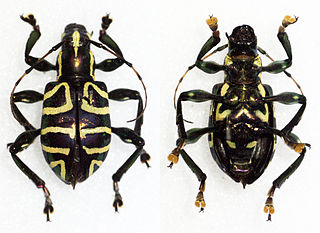
Amantis is a genus of praying mantids native to Asia and the islands of the Pacific Ocean and now belongs to the monotypic tribe Amantini of the subfamily Iridopteryginae.
Amantis basilana is a species of praying mantis native to the Philippines.

Eurema alitha, the scalloped grass yellow, is a butterfly species in the genus Eurema. It was first described as Terias alitha by father and son entomologists Cajetan and Rudolf Felder in 1862. It is found in Southeast Asia.

Doliops is a genus of beetles in the family Cerambycidae, containing the following species:
Serixia is a genus of longhorn beetles of the subfamily Lamiinae, containing the following species:
Sybra basilana is a species of beetle in the family Cerambycidae. It was described by Breuning in 1939.
Pterolophia basilana is a species of beetle in the family Cerambycidae. It was described by Stephan von Breuning in 1938.
Glenea basilana is a species of beetle in the family Cerambycidae. It was described by Maurice Pic in 1943.
Serixia buruensis is a species of beetle in the family Cerambycidae. It was described by Stephan von Breuning in 1958.
Serixia cinereotomentosa is a species of beetle in the family Cerambycidae. It was described by Stephan von Breuning in 1958.
Serixia novaebritanniae is a species of beetle in the family Cerambycidae. It was described by Stephan von Breuning in 1958.
Serixia nilghirica is a species of beetle in the family Cerambycidae. It was described by Stephan von Breuning in 1963.
Serixia literata is a species of beetle in the family Cerambycidae. It was described by Francis Polkinghorne Pascoe in 1858. It is known from Malaysia, Borneo and Sulawesi.
Serixia longicornis is a species of beetle in the family Cerambycidae. It was described by Francis Polkinghorne Pascoe in 1858.
Serixia prolata is a species of beetle in the family Cerambycidae. It was described by Francis Polkinghorne Pascoe in 1858.
Serixia sedata is a species of beetle in the family Cerambycidae. It was described by Francis Polkinghorne Pascoe in 1862.
Serixia phaeoptera is a species of beetle in the family Cerambycidae. It was described by Per Olof Christopher Aurivillius in 1927.
Serixia nigroapicalis is a species of long horn beetle in the family Cerambycidae. It was described by Per Olof Christopher Aurivillius in 1927. This species is also part of the genus Serixia, order Coleoptera, class Insecta, phylum Arthropoda, and kingdom Animalia. These beetles can drill into wood and cause damage to live wood.
Serixia atritarsis is a species of beetle in the family Cerambycidae. It was described by Maurice Pic in 1929.
Serixia inconspicua is a species of beetle in the family Cerambycidae. It was described by Gardiner in 1936.


